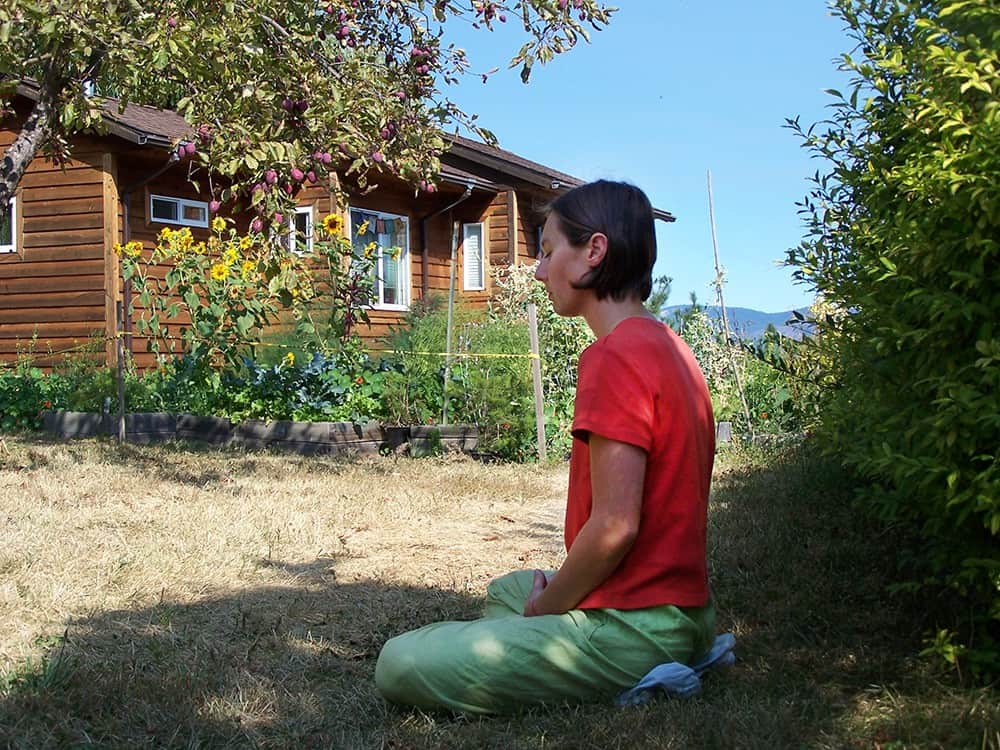Cultivating connection, compassion, and confidence in goodness while healing after suicide

In early 2006, Venerable Thubten Chodron received an invitation to speak at a conference for survivors of suicide. Below were her preliminary thoughts about what to say, which she left aside at the conference and spoke simply as one human being to another. You may also wish to listen to the talk that she gave on the loss of a loved one to suicide. (This article is to be included in the forthcoming publication The Suicide Funeral (or Memorial Service): Honoring their Memory, Comforting their Survivors, edited by James T. Clemons, PhD, Melinda Moore, PhD, and Rabbi Daniel A. Roberts.)
It is my honor and privilege to be able to share some reflections with such an esteemed audience, a group of people who genuinely and sincerely care about other living beings. That care and affection for others—that feeling of being connected—is an important element in living a meaningful life. Related to that is feeling that there is something basically good and pure about us human beings, despite our suffering and anger. We are aware that we have special potential simply because we have a mind/heart, that our life is not one condemned to alienation, self-hatred, guilt, and resentment. In Buddhist language, we call that “Buddha nature” or “Buddha potential”—the completely clear nature of our mind/heart that is the foundation upon which we can develop amazing qualities such as impartial love and compassion for all living beings and a wisdom that knows the ultimate reality of all existence.
I would like to talk more about these two—the feeling of connection with others that leads to compassion and the awareness of our inner goodness or “potential for enlightenment”—because they are connected with both suicide and healing after the suicide of a dear one.
First, let’s investigate how they are related to suicide itself. Suicide often stems from depression. While, in some cases, depression may be due to chemical imbalance or interfering forces, nevertheless some prominent thoughts ransack the mind, provoking some people to consider suicide as a way to alleviate their misery. These are thoughts such as, “My life is useless,” “There is no hope for happiness in my life,” and “I am not worthwhile enough to live.” On what grounds does the thought “My life is useless” arise? Its basis is not feeling connected with others or with one’s environment in a meaningful way. Is it true that we are not or can never be connected with others in a meaningful way? No, of course not. While such a thought may exist, its contents are unrealistic for, in fact, we are deeply connected with and related to all living beings. We depend on each other throughout our lives. Whatever work we do in society contributes to the wellbeing of others. Even a small interaction with someone—a smile, a “thank you,” a few words—makes a difference in others’ lives. Petting an animal and feeding the birds gives affection to those beings. We have such interactions all day long.
How can we oppose this unrealistic view that we are disconnected from others? Just telling ourselves to feel loving, loved, or connected does not work. We have to actively train our mind/heart to look at life from a different perspective. When this is done, positive emotions will naturally arise. In light of this, the Buddha laid out a series of meditations designed to develop love and compassion.
The foundation of this training is seeing that ourselves and others are totally equal in wanting happiness and wishing to avoid any and all kinds of suffering. We contemplate this deeply and repeatedly, not just repeating the words at an intellectual level, but bringing them into our heart. In this way, we train our mind/heart so that every time we see any living being—no matter who they are, whether we like them or not—our spontaneous awareness is “This living being is exactly like me. The most important thing for him or her is happiness and avoiding suffering. Recognizing this, I understand something very important, very intimate about others. We are indeed interconnected.” Even if we’ve never met someone, we know that this is how that person feels. Even animals and insects have happiness and the eradication of misery as the most important purposes of their lives. When we continually train our mind to see everyone in this way, we no longer feel alienated. Instead, we feel and know that we are enmeshed in this interconnected body of living beings. We belong, we understand others, and they can understand us. Our actions affect them; we are not isolated, walled-in units, but part of the whole network of living beings throughout this universe. Our problems are not unique and hopeless. We can allow ourselves to receive others’ affection and aid. We can also reach out to help other beings and to contribute to their happiness, even in small ways that become deeply meaningful. Our life has purpose.
Not only does our life have meaning, but we deserve to live. We are a worthy living being. Why? Because our basic nature is something good, something pure. Sure we have all sorts of disturbing emotions, but they are not us. They are mental events, things that arise, pass though, and leave our minds. We are not our thoughts and feelings. They are not us. When we sit in meditation and are mindful of our thoughts and feelings, this becomes quite evident. Underneath them is the basic clear and knowing nature of mind/heart, which is free from all thoughts and emotions. On a deeper level, our nature is like the pure and clear open sky. Clouds may pass through it but the sky and the clouds are not the same nature. Even when the clouds are present, the pure and open sky still exists; it can never be destroyed. Similarly, the nature of our mind is not inherently defiled; the disturbing attitudes and emotions are adventitious.
Not only are disturbing emotions transient, they are also distorted—they are not based on an accurate view of what is happening and do not give rise beneficial responses to situations. Instead of believing everything we think and feel, we investigate our thoughts and feelings to discern if they are accurate and beneficial. Should we discover they aren’t, we apply antidotes by training our mind to view situations in a different way, one that is more realistic and beneficial. As we do this, we discover that our “take” on life changes; we discover our inner goodness. We are worthwhile and have been valuable members of society all along. Now we see it.
How do these points—connection, compassion, and potential for enlightenment—relate to those healing from suicide? First, compassion for ourselves and for the one who completed suicide is called for. It’s easy to feel guilty and blame ourselves for another’s suicide; it’s easy to be angry at them for making us suffer; it’s easy to sink into our grief at losing a loved one and become immersed in self-pity. But these emotions are like clouds in the sky of the spacious purity of our mind/heart. They are not us, we are not them. They arise and pass through our minds. There is no benefit to grasping onto disturbing emotions and imbuing them with a reality that they don’t have.
In addition, all those feelings—guilt, anger, resentment, self-pity—are functions of our self-preoccupied attitude. It is this self-centeredness that has kept us trapped in misery from time without beginning. Not only is self-centeredness not beneficial for our own or others’ happiness, but it’s also not realistic—there are infinite living beings. Let’s place our own pain within the perspective of all the varied experiences that living beings have at this moment.
That doesn’t mean we’re bad if we temporarily get stuck in disturbing emotions. Let’s not add another layer of delusion on top of what we’re already feeling by telling ourselves that we’re selfish and wrong for being depressed or self-preoccupied. Rather, since those are unrealistic and unbeneficial feelings, let’s ask ourselves, “What are more realistic and suitable ones? How do I cultivate them?”
Here is where compassion for ourselves comes in. Compassion is not self-pity. Rather, it acknowledges our pain and confusion, wishes ourselves to be free from them, and then moves on.
What does it move on to? What do we consciously cultivate? A heart that cares about others. The feeling of connection and compassion we had for the dear one who completed suicide is compassion for one living being. There are infinite living beings throughout the universe. What would happen if we were to take down the walls of obsessive clinging to one person and open our hearts to loving all beings simply because they exist? We can share the love we had for one person with many others, increasing our capacity to give and receive love while we do so.
Several years ago, I was asked to preside over a memorial service for a man in his thirties who had died of cancer. When his wife spoke at the service, she was radiant. She said, “John, I’m going to take all that love you gave me, all the love we shared together, into my heart. And then, because it’s not something that can ever diminish, I’m going to spread it out from my heart to everyone I encounter.” I was tremendously moved by what she said, and I’m sure her husband would have been as well.
Grief after the death of a loved one is not about missing them in the present as much as realizing that our image of the future—a future which had included them—needs to be revised. In other words, we’re not mourning the past, we’re mourning the future. But the future never was. This future was only our conception, so why cling onto something that was never there? Instead, let’s rejoice that we knew this person for as long as we did. How wonderful that we were able to share and to learn from each other for that time. Everything is transient; and we were so fortunate to have them in our lives and to love them and be loved by them for as long as that happened.
What an incredible way to heal from the death of a loved one—to rejoice at the time we had together instead of to mourn for the future that never was and will never be. How meaningful it is to share the love we have for one person by opening our hearts to all others and sharing that love with them. This enables us to have love and compassion for our loved one as we send them off with love, wishing them the best, knowing that they have the potential for enlightenment and praying that they will tap into their internal goodness in the future. We, too, have this potential for enlightenment, so let’s access it within our own heart and mind and having done so, live peacefully within ourselves and make a positive contribution to the well-being of others.
Many of you survivors have used compassion for others to help you heal after the death of your loved one. Your compassion led you to organize this conference, to set forth initiatives for government programs and policies, to begin suicide prevention programs, support groups, and so on. I commend your compassionate efforts to help others and know that you and they will experience the beneficial results of that.
Some of you are still fresh in your grief. You are not ready to do this yet. But trust in yourself that you will reach the point where you can transform your experience into something that activates you to connect with others and to help them.
Many of you may be curious about the role of meditation in developing these perspectives. There are many forms of meditation. One type that is useful is called “mindfulness meditation.” Here we may focus on our breath, physical sensations, feelings, mind, or thoughts and simply observe them, letting them arise and pass without clinging onto them. By doing this, we come to see these as simply events, nothing permanent to get attached to or hold onto. Our mind relaxes. We also begin to see that these mental and physical events are not us; we see that there is no solid “I” or “mine” to control or possess all these physical and mental events. This releases the stress in our minds.
A second type of meditation is what is called “analytic” or “checking” meditation. Here a genre of teachings entitled “mind training” or “thought transformation” is very effective. The thought training teachings instruct us how to actively develop a feeling of connection equally for all living beings. They show the method to cultivate love, compassion, joy, and equanimity. They also teach how to transform adverse circumstances into the path to enlightenment—a very useful skill. Let me recommend a few books on this topic: An Open-Hearted Life, Transforming Adversity into Joy and Courage, Advice from a Spiritual Friend, Don’t Believe Everything You Think, Thought Training like Rays of the Sun, Mindfulness in Plain English, and The Miracle of Mindfulness. You may also want to attend talks given by qualified Buddhist teachers.
These are some perspectives. Thank you for allowing me to share them with you. I hope they will be useful to you as they have been for me.
Venerable Thubten Chodron
Venerable Chodron emphasizes the practical application of Buddha’s teachings in our daily lives and is especially skilled at explaining them in ways easily understood and practiced by Westerners. She is well known for her warm, humorous, and lucid teachings. She was ordained as a Buddhist nun in 1977 by Kyabje Ling Rinpoche in Dharamsala, India, and in 1986 she received bhikshuni (full) ordination in Taiwan. Read her full bio.


